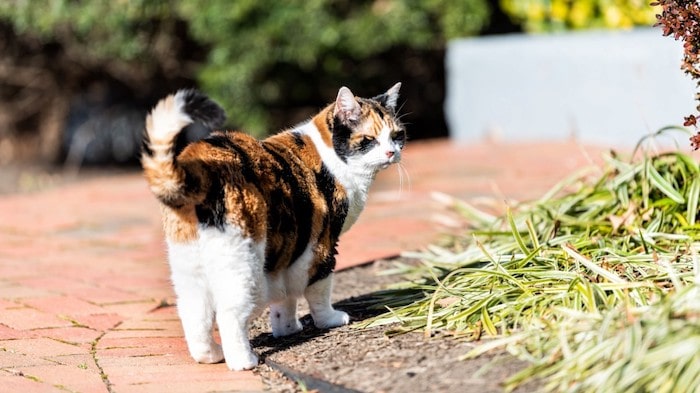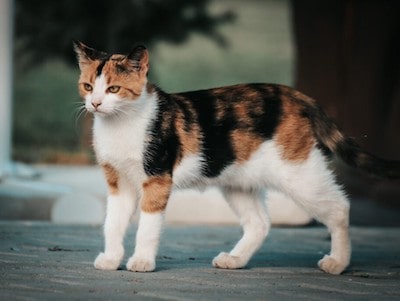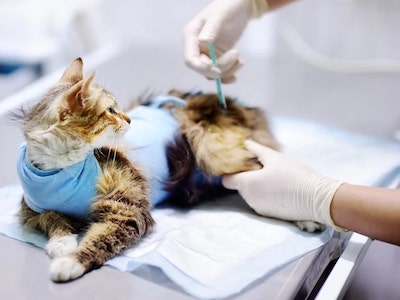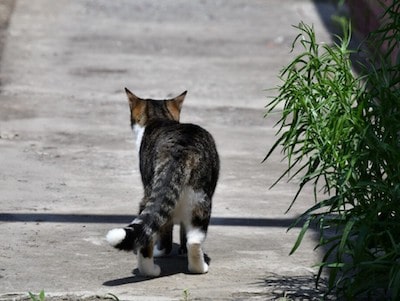If you’ve ever noticed your cat’s hind legs appearing unusually close together or turned inward, you may be witnessing this intriguing phenomenon.
In this article, we will explore what cow hocking in cats entails, the potential causes behind it, common symptoms to watch for, and the available treatment options.
Whether you’re a concerned cat owner or simply curious about feline anatomy, join us as we unravel the mysteries of cow hocking in cats and uncover ways to ensure our furry friends lead healthy, active lives.
So, let’s dive in and learn more about this fascinating condition that impacts our feline companions.
What Is Cow Hocked In Cats?
Cow hocked deformity is a term used to describe a specific physical condition in cats where the hind legs turn inward, causing the hocks (the joints in the hind legs) to appear closer together.
This can be due to genetics or injury. Cow hocked cats may have difficulty walking and may develop arthritis or joint pain over time.
Cow hocked deformity is also known as cow hocks or bowleggedness. It is called cow-hocked because it resembles the body structure of cattle.
Aside from making your cat look physically different, cow-hocked legs can make your cat’s life painful. This seemingly goofy deformity could lead to spine and hind leg issues, so it’s essential to find the correct treatment for your cat.

Causes of Cow Hocked Deformity in Cats
Cow hocked deformity in cats can have various causes, ranging from genetic factors to environmental influences. Some of the possible causes are:
- Genetic factors: Some breeds or lines of cats may have a genetic predisposition to cow hocked deformity. For example, some Persian cats may have a shorter and more curved femur (the bone in the upper part of the hind leg) than other breeds, which can result in cow hocked legs. Other breeds that may be more prone to cow hocked deformity include Himalayan, Scottish Fold, Munchkin, and Manx.
- Developmental issues: Some cats may develop cow hocked deformity during their growth period, especially if they are exposed to poor nutrition, inadequate exercise, or overcrowding. These factors can affect the development of the bones, muscles, tendons, and ligaments in the hind legs, leading to abnormal alignment and angulation.
- Nutritional imbalances: A lack of certain nutrients, such as calcium, phosphorus, vitamin D, or protein, can also cause cow hocked deformity in cats. These nutrients are essential for the proper formation and maintenance of the skeletal system. A deficiency or excess of these nutrients can lead to weak or malformed bones and joints.
- Medical conditions: Some medical conditions can also cause or contribute to cow hocked deformity in cats. For example, diabetes can cause nerve damage and muscle weakness in the hind legs, which can affect the cat’s gait and posture. Other conditions that can cause cow hocked deformity include rickets (a disease that affects bone mineralization), arthritis (a disease that causes inflammation and degeneration of the joints), or trauma or injury to the hind legs.
Potential Consequences And Complications Of Cow Hocked Deformity
Cow hocked deformity can have various effects on a cat’s health and well-being, depending on the severity and cause of the condition. Some of the possible consequences and complications are:
- Arthritis: The abnormal alignment of the hind legs can put extra stress on the joints, leading to inflammation, degeneration, and pain. Arthritis can affect a cat’s mobility and quality of life, especially as they age.
- Spinal damage: The deviation of the hind legs can also affect the alignment of the spine, causing it to curve or twist abnormally. This can result in nerve compression, disc herniation, or spinal cord injury, which can cause pain, weakness, or paralysis.
- Reduced defense: Cats with cow hock deformity may have difficulty defending themselves against predators or other threats, due to their reduced speed and agility. They may also be more vulnerable to injuries or infections in their hind legs.

Treatment Options And Preventive Measures For Cow Hocked Deformity
The treatment options for cow hocked deformity in cats depend on the cause and severity of the condition, as well as the cat’s age and overall health. Some of the available treatment options are:
- Surgery: In some cases, surgery may be performed to correct the alignment of the bones and joints in the hind legs. This can improve a cat’s mobility and comfort, as well as prevent further complications. However, surgery may not be suitable for all cats, and it may involve risks and recovery time.
- Braces: Braces are devices that are fitted around the hind legs to provide support and stability. They can help a cat walk more normally and reduce pain and inflammation in the joints. Braces may be custom-made or purchased online, but they should be used under veterinary supervision.
- Physical therapy: Physical therapy is a form of rehabilitation that involves exercises and massages to improve a cat’s strength, flexibility, and range of motion. Physical therapy can help a cat recover from surgery or injury, as well as prevent muscle atrophy or stiffness.
- Medication: Medication may be prescribed to relieve pain and inflammation in the joints, such as nonsteroidal anti-inflammatory drugs (NSAIDs) or corticosteroids. Medication may also be used to treat underlying conditions that may cause or worsen cow hocked deformity, such as diabetes or vitamin deficiency.

Some preventive measures for cow hocked deformity are:
- Proper nutrition: A balanced diet that provides adequate protein, calcium, and other nutrients can help a cat’s bones and muscles develop normally and prevent nutritional imbalances that may cause deformity.
- Exercise: Regular exercise that is appropriate for a cat’s age and health can help a cat maintain a healthy weight and muscle mass, as well as prevent joint stiffness and pain.
- Breeding practices: Responsible breeding practices that avoid inbreeding or selecting for extreme traits can help prevent genetic factors that may cause cow hocked deformity. Breeders should also screen their cats for any signs of deformity or disease before mating them.
How to Prevent Cow Hocked Deformity in Kittens and Breeding Programs
Cow hocked deformity in cats can be prevented or reduced by taking some preventive measures, especially in kittens and breeding programs. Some of these measures include:
- Select healthy and sound breeding cats: Cat breeders should select healthy and sound breeding cats that do not have any signs of cow hock deformity or other structural abnormalities. Cat breeders should also avoid inbreeding or overbreeding, which can increase the risk of genetic defects and health problems in the offspring.

- Monitor the growth and development of kittens: Cat breeders and owners should monitor the growth and development of kittens and check for any signs of cow hock deformity or other issues. Cat breeders and owners should also provide adequate nutrition, exercise, and socialization for kittens to ensure their optimal health and well-being.
- Seek veterinary advice: Cat breeders and owners should seek veterinary advice before breeding their cats or adopting a kitten. Veterinarians can provide guidance on how to select suitable breeding cats or kittens, how to perform genetic tests or screening, how to prevent or treat cow hock deformity or other conditions, and how to care for pregnant cats or newborn kittens.
FAQs
How can I identify if my cat has cow hocking?
Observing your cat’s gait and hind leg alignment is key to identifying cow hocking. Look for signs such as the hind legs appearing closer together, turned inward, or a noticeable wobble when the cat walks. If you notice any abnormalities, it’s best to consult with a veterinarian for a proper diagnosis.
Can cow hocking affect a cat’s ability to jump or climb?
Depending on the severity of the cow hocking, it can impact a cat’s ability to jump or climb. Cats with more pronounced leg alignment issues may have difficulty with these activities, while others may adapt and find alternative ways to navigate their environment.
Is cow hocking in cats a hereditary condition?
There is evidence to suggest that cow hocking can have a genetic component, making it more likely to be passed on to offspring. Responsible breeding practices can help minimize the occurrence of this condition in future generations.
Can cow hocking worsen with age?
Cow hocking can potentially worsen with age, especially if it leads to joint degeneration or muscle imbalances. Regular veterinary monitoring and appropriate management can help slow down any progression and maintain the cat’s mobility.
Well, That’s a Wrap
Cow hocked deformity is a condition that affects the alignment of a cat’s hind legs, causing them to appear bowlegged or “cow hocked.” This condition can have various causes, such as genetic factors, developmental issues, nutritional imbalances, or medical conditions.
Cow hocked deformity can also have various consequences, such as reduced mobility, early-onset arthritis, spinal damage, or reduced quality of life.
Cow hocked deformity can be identified and diagnosed by a veterinarian based on physical examination, observation of gait and posture, and diagnostic tests. Cow hocked deformity can be treated by various options, such as surgery, physical therapy, medication, or supportive measures.
Cow hocked deformity can also be prevented or reduced by selecting healthy and sound breeding cats or kittens, monitoring their growth and development, and seeking veterinary advice.
